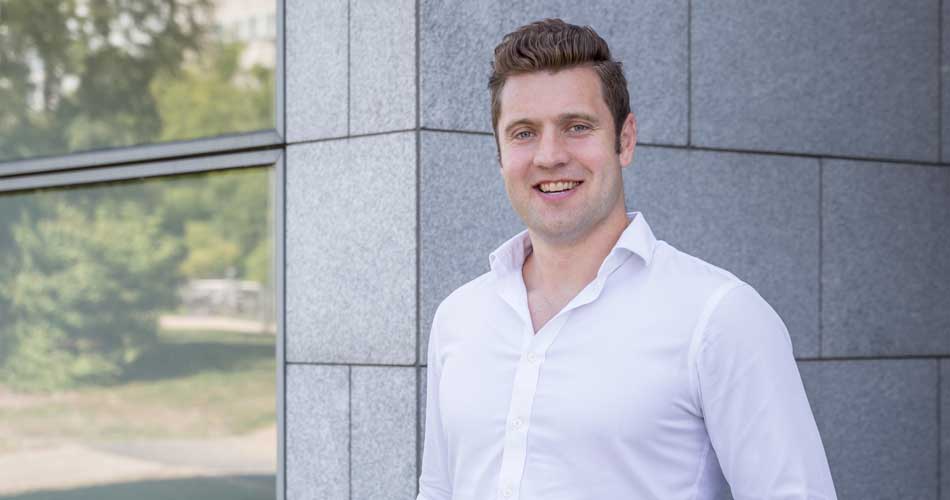Engineering design to solve long-term problems in energy storage and medicine

Dr Philip Donnellan of the UCD School of Chemical & Bioprocess Engineering
Engineers solve problems, and Dr Philip Donnellan currently has two main problems in mind. One is how to store energy generated from renewable sources such as wind or solar, so that we can capture that energy when it is plentiful and use it at a later time when we need it.
The other is the need to get medicines to patients efficiently and cost-effectively, which is why Dr Donnellan is developing small, portable 3D-printed reactors and units to allow flexible, local medicine manufacturing.
“If you solve the storage problem for renewables, it opens up new generation opportunities, which will increase the proportion of our energy coming from those sources.”
Sustainable Energy and Medicine
We need energy to run our lives and we need medicines when we are sick. In both cases, getting them reliably depends on processes, and this is where Dr Donnellan is innovating with his research.
For energy, he is building a safe, simple system to store harnessed energy from renewable sources such as wind or solar. Not only that, the system will capture carbon to offset emissions.
“The system we are building cools and liquifies air using available energy,” explains Dr Donnellan. “This stores the energy in a compact volume so that when we need electricity, we can easily pressurise the air, turn it back in to a gas, and use it to drive a turbine.”
The system will also have an inbuilt capacity to capture carbon, and it uses existing hardware and technology to bridge that gap between harnessing renewable energy and using it, explains Dr Donnellan. “The project is adapting existing knowledge and systems to address the energy storage problem for renewables,” he says.
For the pharmaceutical industry, the focus of his research is to make manufacturing more compact and flexible. “The idea is to use advanced modelling to allow the development of cheaper, more mobile and even disposable manufacturing options using 3D-printed components,” he explains. “The end goal is to be able to create tailored, portable, disposable mini-factories which could fit in the back of a van and which could be used to produce personalised medicines at a fraction of the current cost.”
Reduced reliance on fossil fuels
Burning fossil fuels releases an unsustainable burden of carbon dioxide and other climate-affecting gases into the atmosphere, so the push is on to generate a greater proportion of the electricity we need from renewable sources. However, without a way to store such energy, we will always still rely on fossil fuels as a backup, notes Dr Donnellan.
“We can’t be completely reliant on renewables because they are not consistent, you can’t guarantee that the energy will be produced when you need it, so we want to be able to store that energy at times when an excess amount of it is being produced so that it can be used whenever the demand is there,” he says.
Significant research is taking place in areas such as hydrogen storage and the development of batteries however issues of safety and cost are still present and widespread commercial solutions have not yet been rolled out.
Storing the produced energy in the form of high pressure compressed air in large underground caverns or tanks is another option, but Dr Donnellan is taking it further by using the renewably-sourced energy to actually turn the air in to a liquid. “This vastly reduces the space it takes up,” he explains. “It means you can store hundreds of times more energy in the same volume of space.”
Dr Donnellan’s group is building a prototype of the energy-storage system at UCD. “It’s only the second prototype of this kind of system in the world,” he says.
The safety profile of the system as designed is also quite favourable. “It uses simple tanks, pumps, compressors - all technologies that people are comfortable with, and if it leaks, it leaks air,” says Dr Donnellan. “This is the kind of system you could have next to a wind farm, a factory, or a house without generating any safety concerns.”
In theory, this type of technology could lead to greater availability of renewably-sourced energy and in the future hopefully significantly reducing the need for fossil fuels, notes Dr Donnellan. “If you solve the storage problem for renewables, it opens up new generation opportunities, which will increase the proportion of our energy coming from those sources.”
Increasing the flexibility of pharma manufacturing
As well as creating a bridge between energy generation and consumption in the form of safe storage, Dr Donnellan wants to bridge the gap between the manufacture of medicines and the patients who need them.
His team has developed 3D-printed reactors and other components to make medicines, and the key is using mathematical modelling to optimise the design. “We have managed to reduce the volume of specific chemical reactors to the size of a pen, and our ambition is to have this type of effect on the entire manufacturing sequence” he says.
The project is focusing on redesigning and automating the manufacturing process and Dr Donnellan hopes that this will open up new avenues for companies and hospitals to make medicines locally and in an economically viable manner.
“We want to change the supply chain,” he says. “The impact would be that medicines could be made locally at a lower cost, which could increase access to medications in developing countries, and for people with rare diseases. It is also meant to reduce the time and cost required to bring drugs to clinic trial - potentially opening up possibilities for exploring a wider range of new medicines.”